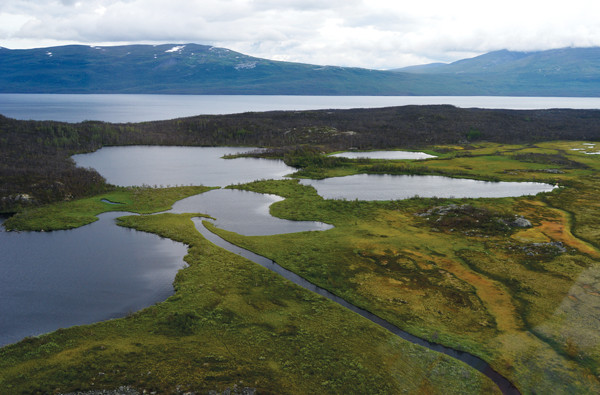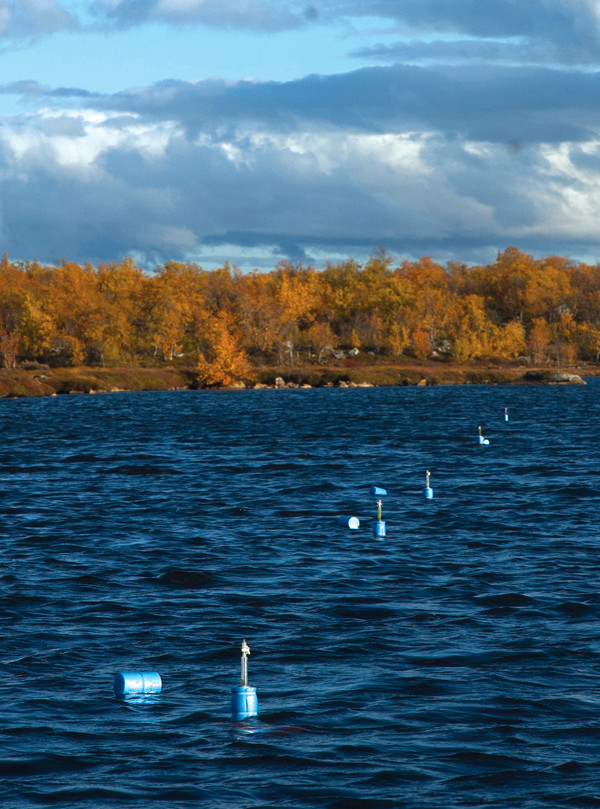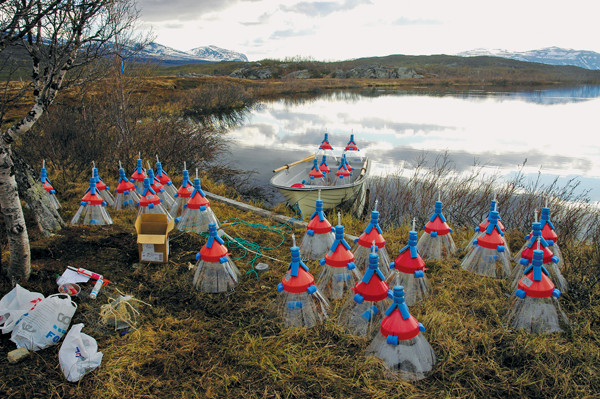
by Jessica Orwig Thursday, May 15, 2014

An aerial view of some of the subarctic lakes in Sweden studied by Martin Wik and his team. Credit: Jo Uhlbäck
Each summer, frozen ground in Arctic and subarctic regions, called permafrost, thaws and releases accumulated methane. For years, scientists have searched for a clear-cut way to estimate the amount of this potent greenhouse gas that these areas contribute to the atmosphere and the changing climate. Now, they have come one step closer to solving part of the problem.
Permafrost thaw introduces methane into the atmosphere directly, but it also dumps nutrient-rich sediments into lakes, which are an additional methane source. One of the longest continuous studies of its kind has revealed an unexpectedly simple relationship: The more sunlight that subarctic lakes absorb, the more methane they emit. The results, researchers suggested in Geophysical Research Letters, could improve climate models and help explain melting rates of Arctic sea ice.

Scientists placed dozens of methane traps across lake surfaces, enabling them to trap a large enough sample to estimate the lakes' total methane emission rates. Credit: Martin Wik and Brett Thornton.
Methane-producing microbes survive on the nutrient-rich soils that comprise the lakebeds in many Arctic and subarctic regions. The microbes release methane at the bottom of the lake, and the gas then rises to the surface and escapes to the atmosphere. The amount of gas that reaches the surface is highly variable over time and at different locations. Therefore, it’s difficult to measure, says Martin Wik, a geology graduate student at Stockholm University in Sweden and lead author of the study.
Monitoring a single spot for a period of weeks or months will do little for understanding a lake’s emissions as a whole, Wik says. Yet, few studies offer any long-term, widespread observations of these methane-belching lakes, if for no other reason than that most are remote, making them difficult and expensive to study on a regular basis, Wik says.
From 2009 to 2012, Wik and a few colleagues made daily or weekly visits during the spring, summer and fall seasons to three subarctic lakes in the Stordalen mire region in northern Sweden — a 13-hour drive from Stockholm. Over those four years, they took measurements on each visit using a detailed technique that captured the lakes’ average methane-release rate.

Small plastic traps were used to measure methane emission rates from the lakes. Credit: Martin Wik and Brett Thornton
In a tiny boat, the scientists rowed across each lake and distributed 40 cone-shaped methane traps across the surface. After four years, they had nearly 7,000 total measurements. Sifting through the data, they calculated each lake’s average rate of methane release on a daily and, ultimately, annual timescale.
The scientists kept a close eye on when the lakes began to melt each spring, as that is when they distributed the methane traps across the lakes’ surfaces, removing them the following fall when the lakes iced over again. In 2009, the lakes thawed 30 days earlier than in 2012. They also noticed in 2009 that the lakes emitted close to twice the amount of methane emitted in 2012.
Looking into a possible correlation, the team discovered that when they plotted the lakes’ four seasonal methane emissions against energy absorption from sunlight between 2009 and 2012, the data points indicated a strong, linear relation.
The team also found that shallow sections of lakes bubbled methane at different rates than deeper sections. “Shallow zones bubble more frequently in early and mid-season as they warm faster,” Wik says. “But deep zones tend to take over in September when the shallow zones cool off.”
These methane fluxes have been considered highly variable and unpredictable," Wik says. “We have now shown them to be predictable,” but, he says, the findings were only possible because he and his colleagues observed the lakes over several years. “We couldn’t have found these relationships over a short period of time.”
The Arctic contains millions of mostly shallow lakes that bubble with methane. The relationships the team found are an important first step toward estimating how much methane these lakes emit, says Breck Bowden, a professor of watershed science and planning at the University of Vermont who was not involved with the study.
“The exact … relationship will differ in different geological settings,” but the basic idea “will be helpful in understanding methane emissions,” Bowden says. “The next step is determining how widely … their observation [holds], and do we have that information from other lakes?”
© 2008-2021. All rights reserved. Any copying, redistribution or retransmission of any of the contents of this service without the expressed written permission of the American Geosciences Institute is expressly prohibited. Click here for all copyright requests.